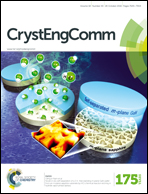Controlled assembly of one-dimensional MoO3@Au hybrid nanostructures as SERS substrates for sensitive melamine detection†‡
Abstract
A new, feasible, and highly efficient platform was developed using self-assembly of (3-aminopropyl) diethoxymethylsilane (ATES) to create metallic oxide-based noble metal nanoparticle hybrid materials. The ex situ approach for fabricating 1D MoO3-nanowires (MoO3-NWs) or ZnO-nanorods (ZnO-NRs) @Au-nanoparticles (Au-NPs) hybrid surface-enhanced Raman scattering (SERS) substrates not only provides a simple route for the decoration of noble metal nanoparticle on metallic oxide nanomaterials, but also realizes the controllable assembly/co-assembly of pre-synthesized nanoparticles with distinctively different sizes, compositions, shapes, and properties. Control over the self-assembly synthesis for morphology and SERS activity was demonstrated by several parameters: (i) coupling agent of ATES, (ii) ATES content, (iii) Au-NPs content, (iv) Au-NP sizes, and (v) other metallic oxide such as ZnO-NRs. The finite difference time domain (FDTD) method was employed to visualize the enhancement mechanism distribution of the hybrid substrate. Furthermore, the optimized MoO3-NW@Au-NPs SERS substrate manifests high SERS sensitivity to melamine with a limit of detection (LOD) of 0.1 ppb (0.08 nM) and excellent uniformity (RSD = 9.26%). The LOD was much lower than the maximal residue limit (MRL) of 2.5 ppm in food prescribed by the US Food and Drug Administration (FDA).


 Please wait while we load your content...
Please wait while we load your content...